|
|
|
|
 |
  |
 |
| |
| Points of Sail |
One of
the most common questions I'm often asked is, "What's
the difference in sail trim between a monohull
and a catamaran?"
As with most things, it really depends on the
boat you sail. I know that there is relatively
very little information on how to sail a
cruising cat, and less information about the
Lagoon 440. So, I have written this information
to help...
The Points of Sail (Left), and
almost all the fundamental sailing concepts apply the same
to both a monohull and catamaran. Of course, the lack of
heeling on a cruising catamaran is very
nice (no need to live life
at a 45-degree angle). ;)
However, this means there are different forces at work on a
catamaran as compared to a monohull (Technically,
a catamaran presents up-to 6x times greater heel resistance
than a monohull). On a
catamaran, the indicators to adjust and relive pressure are
much more "subtle"...this is where understanding sail trim
on a catamaran becomes extremely important. Knowing when to
apply the righ trim to corresponding wind strength and angle
before the apparent indicators are present is extremely
useful.
Also, it's very important to note; that
with almost no heel and very little feedback from lee or
weather helm, it's more difficult to tell when it's time to
reef (outlined below). This is extremely important
to know, especially when considering that a cruising
catamaran also usually carries much more sail area than a
monohull of the same size. I always like to, "Reef early
and often" - and with the L440's reefing rigging, it is
extremely easy to do!
|
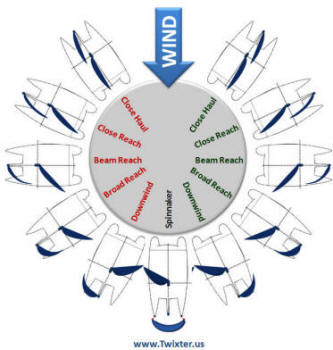 |
|
Trim to Points of Sail |
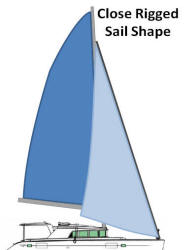 |
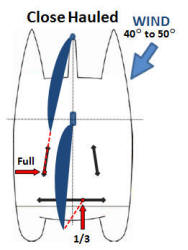 |
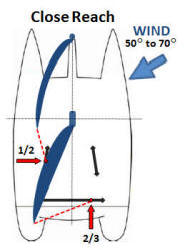 |
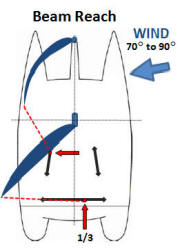 |
You should always trim the sails Angle of
Attack (AoA) to be headed to the apparent wind,
Trimming the sails so that the
airflow leaving the sails are as parallel to each
other as possible and they do not create
turbulence behind the sail.
Remember; cruising catamarans can come to a
quick stop once headed into the wind.
When close rigged, you should avoid pointing a
catamaran as close to the luff line as you would
a monohull. You'll maintain higher average
speeds, and you'll avoid making excessive
leeway.
|
Mainsail: The traveler
is about 1/3 (30cm) to windward of center, boom
centered with mainsail trimmed with a slightly
opened leech, making a very small "pocket".
Genoa:
is trimmed near the spreader, the traveler is full (all the way
aft), so that the angle of the sheet forms a straight line with the clew
and the luff.
Increasing Wind
(15-20 knots): Slacken the main
sheet wile moving the traveler out (up to 2/3
(60cm)) to windward of center, keeping the boom
still in-line.
The Genoa traveler does not change position, but adjust the sheet
so that the leech is out from the spreader
(about 10cm). |
Mainsail:
The traveler is about 2/3 (1m)
windward from center, with the sheet slackened
so that boom is veering out anything from 1m to
2m (depending on the strength and wind angle),
making a slightly increasing the pocket.
Genoa: is slackened (1m
to 1,5m from the spreader), and the traveler is
moved forward to 1/2, so that there is a light
curve with the clew
and the luff forming a small pocket .
Increasing Wind
(15-23 knots): Slacken the main
and Genoa sheets while moving the mainsheet
traveler out (to windward) keeping the boom
in-line. |
Mainsail:
Move the traveler back to about
1/3 (30cm) windward from center. Depending on
the wind angle, the sheet is slackened so that
boom is veering out from 2m to 3m.
Genoa: is slackened (2m
to 3m from the spreader), and the traveler is
moved all the way forward, increasing the curve with the clew
and the luff, and increasing the Genoa pocket and its average attack angle is
about minus 10-degrees from the apparent wind.
NOTE:
In every configuration, no more than one batten
should be allowed to chafe (if any) at
the shroud with the strongest winds. You should
maintain a10cm gap to prevent chafing. |
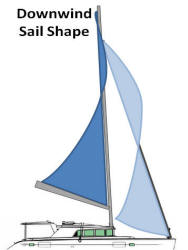 |
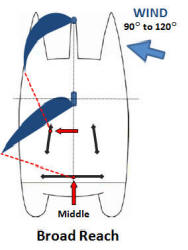 |
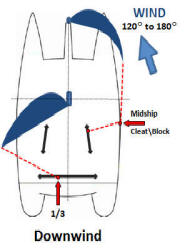 |
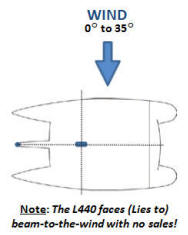 |
Sailing downwind tends to be the best point of sail for a
catamaran (120-degrees for our best
performance). The sail trim is
similar to a monohull.
TIP:
One of the biggest challenges with downwind
sail-trim on the L440 is that the Genoa tracks
are positioned very close inboard on the saloon roof,
and are shorter than a monohull's. Even with the
cars positioned full-forward on the traveler,
the Genoa stays too close inboard. Downwind, you
can use the midships cleat and a snatch-block to
move the Genoa out significantly.
|
Mainsail:
Move the traveler back to center.
Depending on the wind angle, the sheet is
slackened so that boom is veering up and out
from 2m to 3m - making a pocket at the base, and
a slight "twist" at the top.
Genoa: is slackened (3m
to 3.5m from the spreader), increasing the curve with
and sail pocket with a slight "twixt".,,er,,."twist"
at the top.
Increasing Wind
(15-20 knots): Keep mainsail &
Genoa up to 15 knots speed and start to reef as
the wind gusts and increases, or if sea
conditions deteriorate. |
Mainsail:
Move the traveler about 1/3 (30cm)
to full (1m) to leeward. The sheet is slackened
so that the sail is 10cm from the shrouds. Make
sure the mainsail does not touch the shrouds;
the chafing of the battens will destroy the sail
quickly.
Preventer:
Secure the boom via a preventer to the
aft blocks (to prevent accidental jibe).
Genoa: is
"Goose-winged", by leading the sheet through the
midships block, extending the Genoa (absent a
whisker or spinnaker pole).
|
NOTE:
Unlike a monohull, which
naturally heads dead-downwind with no sails, a
multihull will lie beam-to the wind - very
similar to heaving-to in a monohull. This
is a very important
characteristic to understand, especially in an
emergency. To "scud" bare-poles correctly, you
must deploy a drogue or seas-anchore!
TIP: Make sure
that the forward sections of the boat aren't too
heavily loaded when sailing downwind as this
increases the tendency of the bows to dig in.
Remember; in the
L440, the water tanks are located forward of the
center-line (240gl @ 8.35lbs/gl = 2004lbs),
over a ton of water!
|
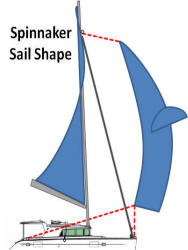 |
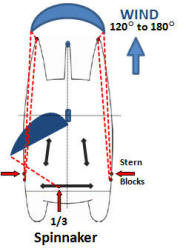 |
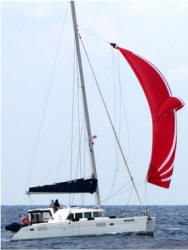 |
|
Many catamaran cruisers like to fly twin
headsails downwind, with one sail poled out on a
whisker pole. Twin headsails
can also be rigged using twin forestays, twin grooves
in a roller-furling track, or a using a two-ply
headsail.
TIP:
If you choose to fly a symmetrical spinnaker, you'll find
that it's much easier on a catamaran because of
the wide foredeck, and a Symmetrical Spinnaker
is perfect for tacking to the twin bows. |
Mainsail:
Move the
traveler about 1/3 (30cm) to 2/3 (60cm) to
leeward. The sheet is slackened so that the sail
is 10cm from the shrouds.
Preventer:
Secure the boom
via a preventer to the aft blocks (to prevent
accidental jibe).
Guys & Sheets:
Lead the guys through the bow blocks and the
sheets outside the shrouds to the aft blocks.
Adjust as needed! |
Caution:
Many catamaran sailors dowse the mainsail and
only fly the head sail or the spinnaker (above). Lagoon
does not recommend this configuration. A raised mainsail
does add support to the
mast and provides coverage for dousing the
spinnaker if-needed.
If configured properly,
It is much easier to fly without the main.
However, we sail only a headsail in light, calm
conditions and tighten the mainsheet & topping
lift accordingly. |
|
|
|
 |
 |
 |
 |
|
 |
  |
 |
| |
|
Reefing |
I, personally, like the
way the L440 is rigged in regards to reefing.
Even though it does take a little "getting
used to", the overall configuration works
great, and is rigged so you only have to leave
the cockpit for the final (3rd) reef.
Like most of the rigging on the L440, you can
reef single-handed if necessary. It's very safe
and easy...
The L440 is fitted with 3 reefs: Reefs 1 and 2
are rigged for automatic reefing (in-sail
blocks and helm cam cleats),
Reef 3 is traditional (you
must go forward to secure the luff eyelet).
The in-sail luff eyelet of reef 3 is fitted with
a strap and a snap shackle to clip on to the
eye-bolt on the boom.
Putting in reefs:
1.
Heading the boat into the wind, pull tight the
topping lift.
2.
Slacken the mainsail sheet and the mainsail
halyard.
3.
Trim reef line as needed*
4.
Close the reef line cam cleat of the respective
reef.
5.
Tighten the mainsail halyard.
6.
Slacken the topping lift and take in the
mainsail sheet.
*Tighten the reef line until the reefing blocks
which correspond to the luff and the leech are a
few centimeters from the boom.
DO NOT OVER
TIGHTEN THE REEF LINES!
Over tightening the reef
lines can result in sever damage to the in-sail
reefing blocks! |
|
Reefing Guidelines (Close Hauled) |
|
Wind |
Main |
Genoa |
Traveler |
Boom |
|
00-15 |
full |
full |
30cm windward |
centered |
|
16-20 |
full |
full |
60cm windward |
centered |
|
21-25 |
1 reef |
70% |
30cm windward |
centered |
|
26-30 |
1 reef |
75% |
60cm windward |
centered |
|
31-35 |
2 reefs |
60% |
30cm windward |
50cm Leeward |
|
36-45 |
2 reefs |
40% |
centered |
1m Leeward |
|
46-55 |
3 reefs |
0% |
centered |
1m Leeward |
|
56 |
Scud\Lie
to\Drogue |
|
|
Reefing Guidelines (Close Reach) |
|
Wind |
Main |
Genoa |
Traveler |
Boom |
|
00-23 |
main full |
full |
0-1m windward |
50cm - 2m |
|
24-28 |
1 reef |
full |
0-1m windward |
50cm - 2m |
|
29-33 |
2 reefs |
80% |
0-1m windward |
50cm - 2m |
|
34-38 |
2 reefs |
60% |
0-1m windward |
50cm - 2m |
|
39-45 |
3 reefs |
40% |
0-1m windward |
50cm - 2m |
|
46-55 |
no main |
30% |
|
|
|
56 |
Scud\Lie
to\Drogue |
|
(*-10% wind speed for rough seas!) |
|
|
|
 |
 |
 |
 |
|
|